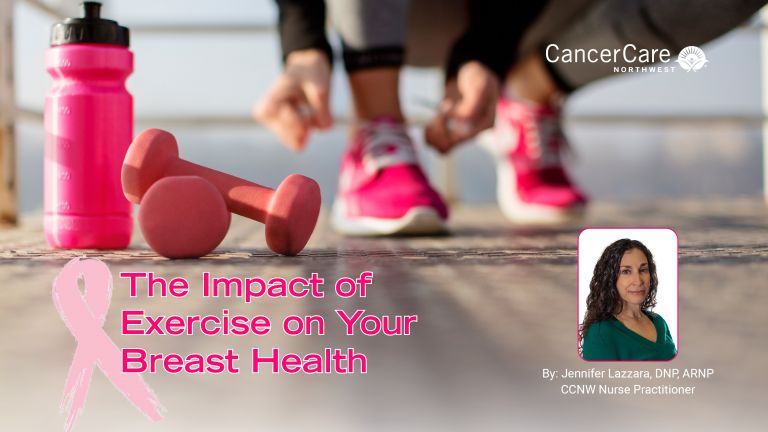
The Impact of Exercise on Your Breast Health
Posted: October 14, 2021
Research has shown us the multiple benefits of exercise before, during, and after breast cancer treatment. We also know inactivity increases the risk of breast cancer recurrence. This is why Cancer Care Northwest encourages our patients to exercise regularly.
Here are some known benefits to exercise after a diagnosis of breast cancer:
- Bone health (Aromatase Inhibitors cause bone loss)
- Weight loss
- Increased self-esteem
- Increased energy
- Decreased stress, anxiety, depression
- Decreased side effects of treatment, such as neuropathy, fatigue, etc.
- 55% lower risk of breast cancer recurrence when minimum guidelines are met (see recommendations below)
- Better balance, lower risk of falls
- Brain health, decreased chemo brain
- Strengthens muscles, increases muscle mass
- Improved quality of life
- Decreases risk of other health problems, such as diabetes, heart disease, other cancers
The recommendation for exercise is:
- Be physically active every day and avoid being inactive for long periods of time.
- Option 1: Moderate-intensity activity for at least 150-300 minutes a week
- Option 2: Vigorous-intensity activity for 75 minutes a week
- Option 3: Mix of moderate and vigorous intensity
- Resistance training to strengthen muscles 2-3 times a week, including:
- Lifting weights
- Using elastic resistance bands
- Using your own body weight against gravity to work your muscles (stairs, hills, lunges, squats, etc.)
We understand that it can be very difficult to start a regular exercise routine. Many patients struggle to find the time, energy, or motivation to start. You may not know what to do for exercise or have other health conditions that can make it difficult to find a form of exercise that can be tolerated or safe for you. Here are some tips to get you started:
- Start slow. Make one small change every 2-3 weeks. For example, go on a brisk walk for 10 minutes, two days a week. After a couple of weeks, increase either the frequency (add a day of exercise during the week), intensity (increase your walking pace), or duration (increase the length of your walk to 15 minutes).
- Be creative with types of exercise. Try a beginners yoga class. Go to a water aerobics class (good for those with back/joint pain). Start with Tai Chi. Find free videos on YouTube to avoid costs. Find opportunities in your community such as senior exercise programs or groups that get together for activities such as hikes or bike rides – there are groups that cater to all levels of fitness.
- Find a workout buddy. We, as humans, are much better at being accountable to someone else than we are to ourselves. It’s just human nature! Having a workout buddy can help keep you motivated and get moving because you have someone else relying on you.
- Join an exercise program. This can be motivating and provide support, education, and make it more fun.
- Make a plan. Set aside time for exercise by writing it down on your calendar. It is easy to make excuses when it is not set in stone. Be firm on this time and do not allow other duties to distract you away from your plan.
- Talk to your care provider. Consult with your CCNW care team if you need help coming up with a plan, finding the right exercise for you, or want to make goals with your provider for future assessment and follow up.
Put exercise on your calendar today. These changes don’t happen on their own… they do require effort, but that effort is worth it. You will feel better, have more energy, and will have taken great steps to reduce your risk of breast cancer recurrence. Keep in mind, you might feel a little more tired at first. Stick to your plan for at least a month and make changes slowly. This will help minimize these side effects when you are getting started. Reach out to your CCNW care team if you need help making or reaching your goals. Now let’s break a sweat!
